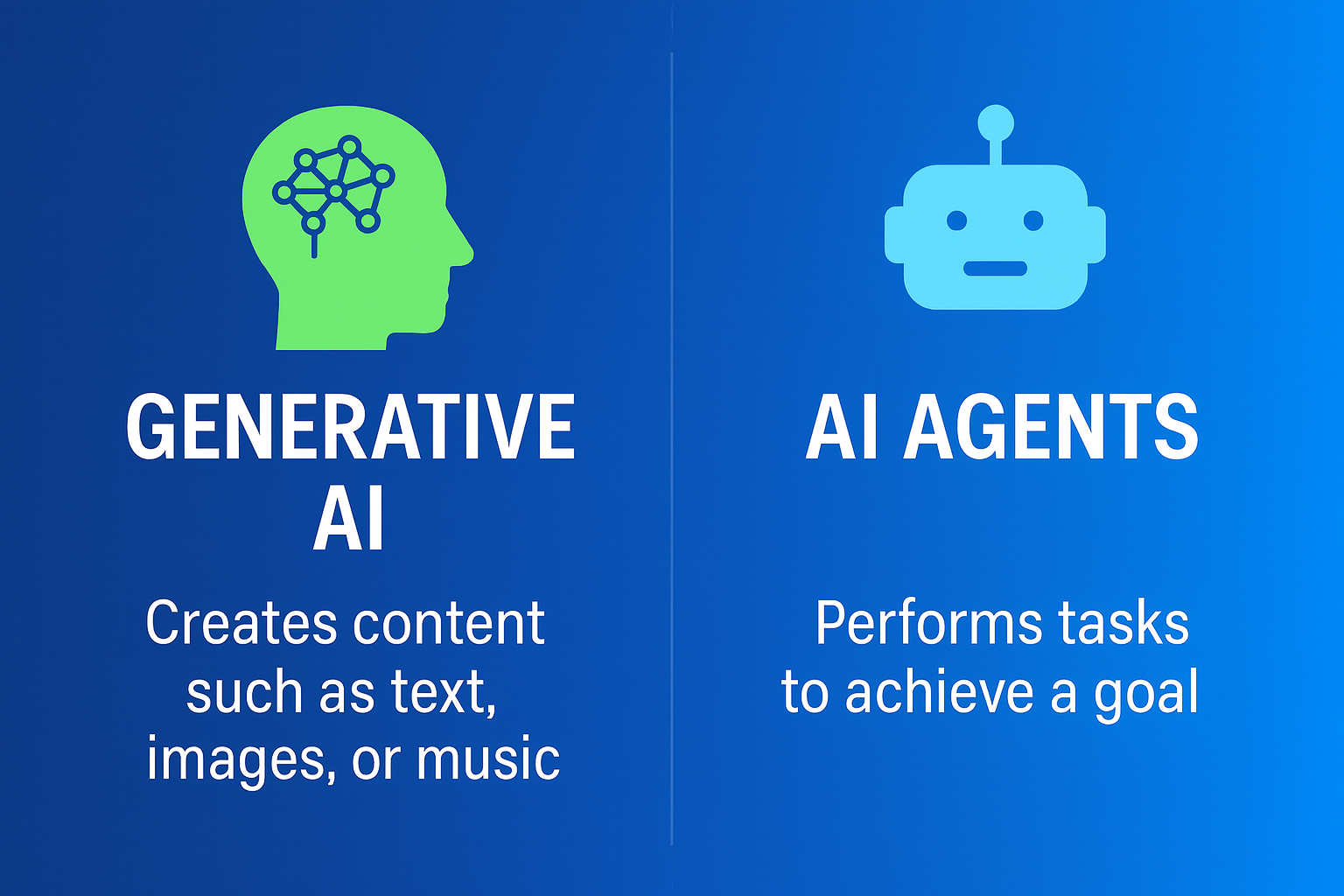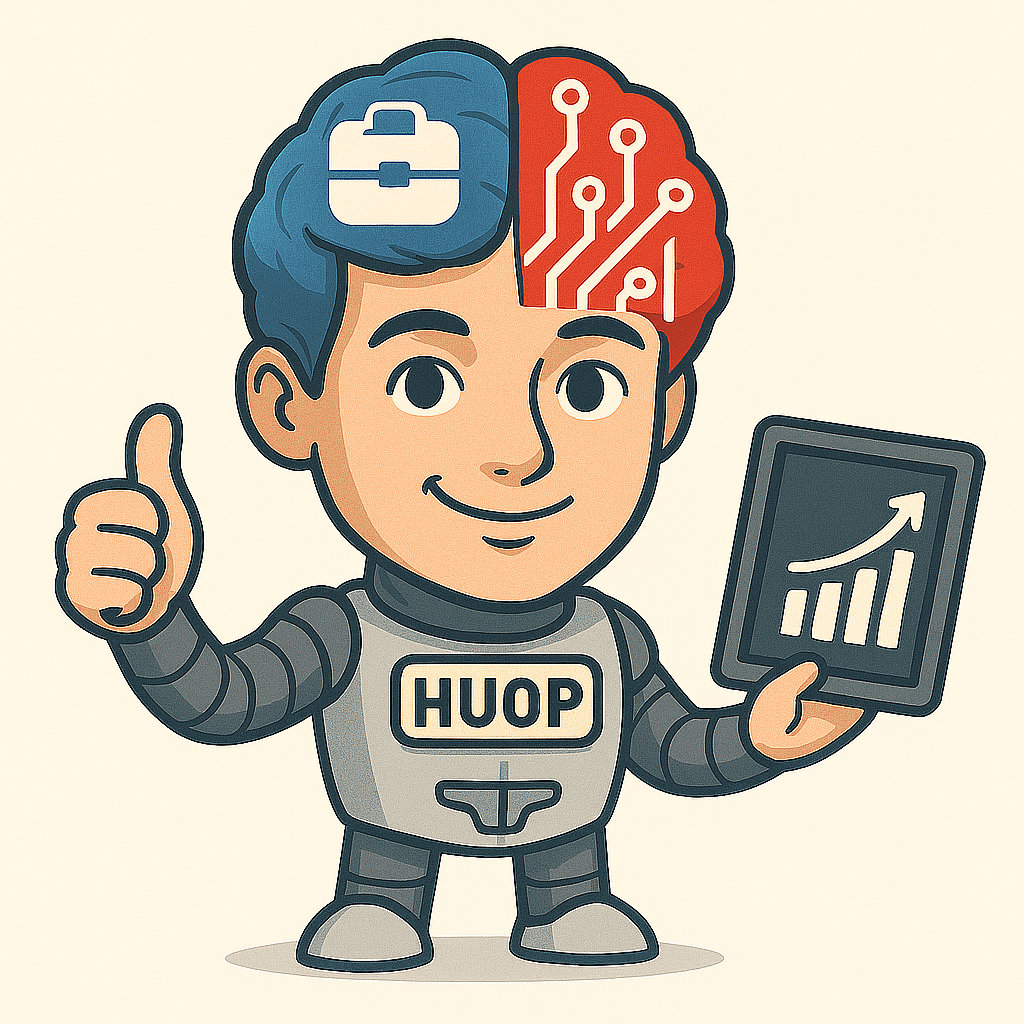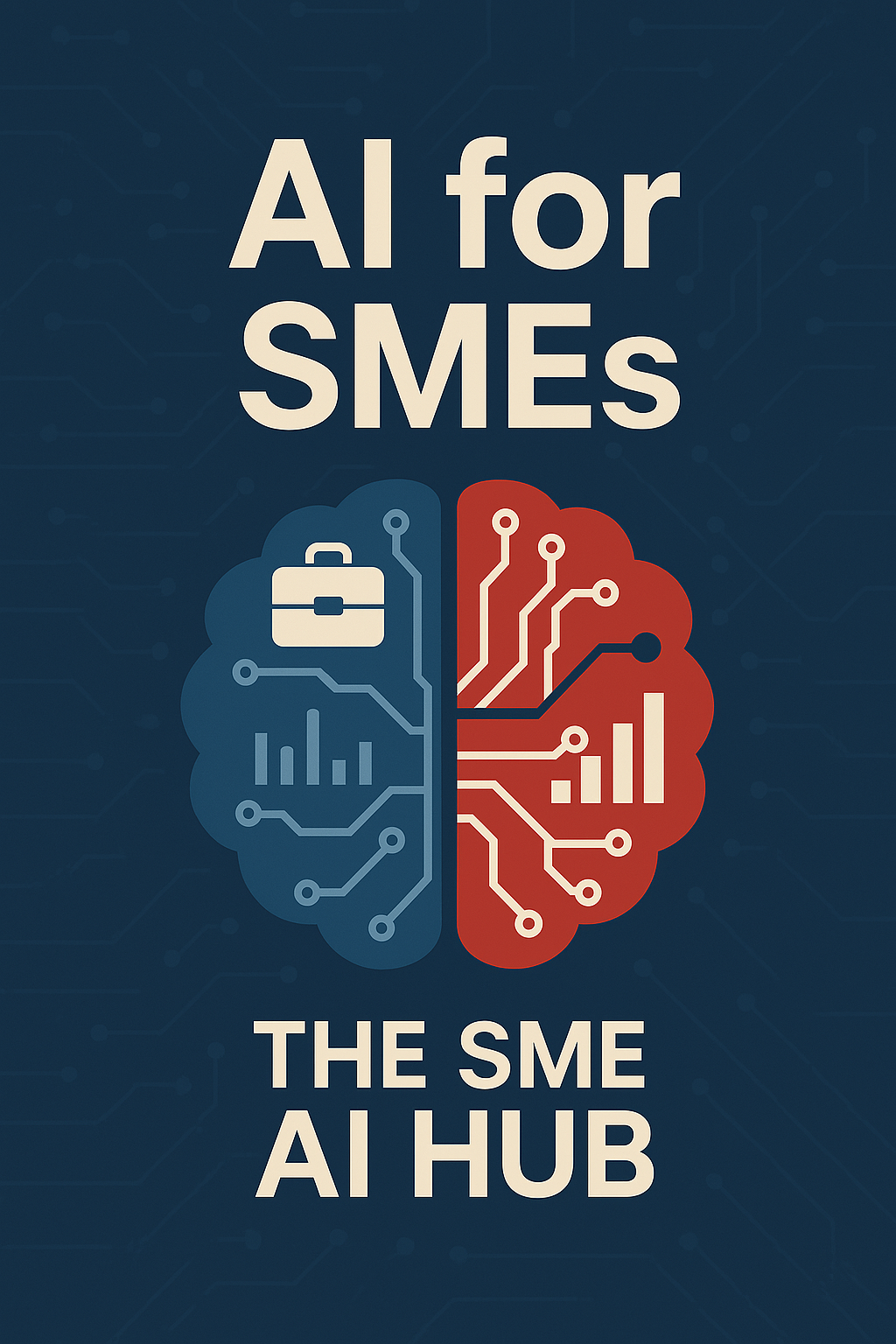Beyond the Headlines: What SMEs Need to Know About AI Agents

Over the past six years, UK SMEs have navigated Brexit, the pandemic, the cost-of-living crisis, political uncertainty, and a challenging economic climate. Since the launch of ChatGPT in late 2022, they’ve also been met with a flood of headlines about artificial intelligence — some inspiring, others overwhelming.
Through this blog series, my goal is to help SMEs cut through the noise and focus on what really matters: understanding what AI is, what it can actually do, and how it can be applied practically in your business.
This month, we’re moving beyond familiar tools like ChatGPT or Google Gemini to explore the next major step in business technology — AI agents.
From Tools to “Digital Colleagues”
Think of generative AI tools (like ChatGPT or Gemini) as powerful assistants. They create content, answer questions, or write code when you ask — but they stop there.
AI agents, on the other hand, act more like digital colleagues. They can:
- Understand a goal you set.
- Break it into smaller steps.
- Take action across your systems.
- Adjust when something doesn’t go as planned.
For example:
- A marketing agent could generate campaign ideas, schedule posts, monitor engagement, and adjust content automatically.
- A finance agent could reconcile invoices, chase payments, and produce cash-flow forecasts without constant direction.
👉 Importantly, today’s agents are not “self-learning employees.” Their ability to improve remains limited — they can retry tasks or adjust their approach, but they don’t build long-term experience like a human colleague. However, research from the Capgemini Research Institute (2025) suggests that the next wave of AI agents will demonstrate stronger reasoning, richer contextual understanding, and deeper integration across business systems — key steps toward making them more capable and reliable collaborators.
Generative AI vs AI Agents
It’s easy to confuse the two, but their roles are distinct:
- Generative AI tools
Respond to prompts and create text, images, or code. They’re powerful assistants but essentially reactive. - AI agents
Take goals, plan tasks, and act across systems to deliver outcomes. They work more proactively within clear boundaries.
In short:
- Generative AI is the engine.
- AI agents are the drivers.
⚖️ What Counts as an AI Agent?
It’s worth remembering that not every tool marketed as an “agent” really is. According to the Capgemini Research Institute (2025), AI agents are systems capable of acting on behalf of users to achieve defined goals. They combine autonomy, reasoning, and contextual understanding to perform tasks — often integrating with other systems or tools to take meaningful action.
In contrast, many tools labelled as “agents” today simply automate single tasks or use AI to generate content — useful, but not truly agentic.
- AI-powered tools – Generative AI platforms such as ChatGPT or Gemini respond to prompts and generate text, images, or ideas. They assist users but can’t take independent action or sustain a goal beyond a single request.
- Agent-like setups – Tools like Zapier, Make.com, or Microsoft Power Automate can behave like agents when connected to AI models. They follow clear, pre-set instructions to move data between apps or trigger workflows — but they lack the reasoning and contextual awareness that define a true AI agent.
- Custom-built agents – For businesses working with a tech partner, it’s now possible to develop more autonomous systems using frameworks such as LangChain, CrewAI, or other open-source toolkits. These enable deeper integration and reasoning, but they typically require technical expertise and careful oversight.
👉 For most SMEs, the best starting point is to explore AI features built into tools you already use, or experiment with simple no-code automations that can demonstrate value quickly before investing in custom solutions.
For example, a small marketing agency might use Zapier to link ChatGPT with Google Sheets and Mailchimp — automatically generating and scheduling weekly newsletter drafts from a content calendar. It’s not a fully autonomous agent, but it shows how connecting AI tools with automation can save time and reduce repetitive tasks.
Adoption and Benefits for SMEs
AI adoption in general is accelerating among smaller businesses:
- Around 37% of UK SMEs report already using some form of AI — the highest rate in Europe (IONOS, 2024).
- The British Chambers of Commerce found that one in four UK businesses now uses AI, while many others plan to explore it (BCC, 2024).
Much of this use so far centres on generative AI tools — such as chat assistants, marketing copywriters, and analytics helpers.
These tools are often the first step for SMEs experimenting with AI. As businesses gain confidence, many are beginning to connect these systems to perform tasks more autonomously — paving the way for the next evolution: AI agents.
The AI agent market itself is growing rapidly. Grand View Research estimates it was worth USD 5.4 billion in 2024 and could reach USD 50.3 billion by 2030 — a compound annual growth rate of almost 46% (Grand View Research, 2025).
While specific adoption data for AI agents in SMEs isn’t yet available, early evidence from broader AI use suggests strong potential. Research from the University of St Andrews indicates that integrating AI into business processes could boost SME productivity by between 27% and 133%, depending on the sector and task complexity (University of St Andrews, 2024).
🚧 Limitations SMEs Should Be Aware Of
AI agents are promising, but they aren’t without challenges. SMEs should keep these in mind:
- Memory limits – agents can lose track of long or multi-day processes (Apideck, 2025).
- Unreliable outputs – “hallucinations” or factual errors can still slip through (Biz4Group, 2025).
- Weak at complex reasoning – great at rule-based tasks, weaker at nuance or strategy (Biz4Group, 2025).
- Integration issues – connecting to older systems can be costly or slow (Biz4Group, 2025).
- Data and compliance risks – agents need access to business data, raising security and regulatory challenges (World Economic Forum, 2024).
- Not truly self-improving – agents can retry tasks and adapt slightly, but they don’t genuinely learn over time (Capgemini Research Institute, 2025).
🔮 Looking Ahead: What to Expect in 2026
Many of today’s limitations are being actively addressed, and progress is already visible across several key areas. While predictions about AI often move faster than reality, current research points toward steady improvement in the coming year.
- Memory and context – Agents are beginning to use vector stores and retrieval-augmented generation (RAG) to retain and recall information, helping them handle more complex, multi-step tasks (Apideck, 2025). Over time, we can expect smoother, more reliable “memory” of past actions and interactions.
- Reasoning and planning – As language models continue to evolve, agents are likely to become better at managing multi-step workflows and adapting mid-task. However, handling ambiguity and novel situations will still require human oversight.
- Governance and oversight – Experts such as Deloitte (2025) and Cube Dev (2025) highlight the growing need for transparent logs, audit trails, and human-in-the-loop controls to ensure that agents remain accountable and trustworthy.
- Emerging SME access – Vendors like Verloop are beginning to integrate agent capabilities into familiar business tools. Over time, these kinds of built-in features may make AI agents more accessible and affordable for SMEs.
- Benchmarking and standards – As more organisations pilot agentic systems, industry observers expect clearer methods for evaluating agent performance, ROI, and reliability — an important step toward informed adoption.
Even as these advances unfold, one constant remains: humans must stay in the loop. Whether approving final actions, reviewing AI-generated output, or managing exceptions, human judgment and context are what keep AI systems aligned with business goals and ethical standards.

How SMEs Can Start Exploring AI Agents
You don’t need enterprise budgets or an in-house AI team to begin. Most SMEs can start exploring AI agents by building on the tools they already use and focusing on small, measurable wins. Think of it as an evolution — from AI-powered tools, to automation, to true agents.
1. Start with a clear objective
Pick one repetitive or time-consuming task you’d like to improve — for example, sending payment reminders, logging leads, or producing weekly marketing content. Focus on problems where even a small efficiency gain would make a noticeable difference.
2. Use what you already have
Before investing in anything new, check whether your existing software — like Xero, Mailchimp, or HubSpot — has added new AI features. Many now include early “agent-like” functions that can act on your data, trigger workflows, or automate simple decisions.
3. Pilot first
Run a small, time-boxed test (for example, 30 days) to see what value an automation or AI feature delivers. Track time saved, errors reduced, or new insights gained.
4. Try low-code or no-code automation tools
Platforms such as Zapier, Make.com, or Microsoft Power Automate can connect AI models (like ChatGPT or Gemini) to your business apps. This creates agent-like workflows that act on information rather than just generating it — for instance, moving leads from a form into your CRM or summarising weekly customer messages.
5. Partner when you need to
If you want something more advanced, such as a tailored agent that reasons or adapts, work with a trusted IT partner. They can help you test safely and design a small proof of concept before scaling.
6. Keep humans in the loop
Never let an AI agent or automation run without oversight. Review its outputs, set clear rules, and make sure people can step in when needed. Human context and judgment are what turn automation into value.
7. Build understanding and culture
Involve your team early. Start with generative AI tools to build confidence and understanding — things like chat assistants or content generators that show the immediate benefits of AI. Then, as your team becomes more comfortable, begin exploring AI agents and monitor how their capabilities evolve. Emphasise that AI agents are designed to support, not replace, jobs. Encourage experimentation, capture lessons learned, and celebrate small wins to build confidence across your business.
Final Thoughts
The experience of both global enterprises and West Midlands SMEs makes one thing clear: while AI is advancing quickly, its true value lies in thoughtful, purposeful application. For small and medium-sized businesses, AI agents aren’t about replacing people — they’re about giving back time, reducing costs, and bringing new capabilities into your organisation without the need for new hires.
Although we’ve explored the potential progress expected in 2026, the reality is that AI continues to evolve faster than almost any other modern technology. Predictions can shift within months, not years. That’s why SMEs should focus on credible, practical sources that provide grounded insight — not speculation — about what’s changing and how to use it safely.
At AI for SMEs, our goal is to help UK businesses do exactly that: to cut through the noise, understand AI in plain English, and adopt it confidently, responsibly, and at a pace that makes sense for your business.
And finally, even as AI agents become more capable, humans remain central to success. Keeping people “in the loop” — to guide, check, and refine what AI produces — ensures that technology enhances human judgment rather than replaces it. It’s that partnership between human insight and digital capability that will define the most successful businesses in the years ahead.
📚 Sources include
- Capgemini Research Institute (2025) – AI Agents: The Next Digital Colleagues
- Grand View Research (2025) – AI Agents Market Report
- BGF (2024) – SME AI Adoption Report
- University of St Andrews (2025) – AI Could Boost SME Productivity by up to 133%
- techUK (2025) – Major Barriers to AI Adoption Remain for UK Businesses
- Biz4Group (2025) – AI Agent Limitations and Opportunities

